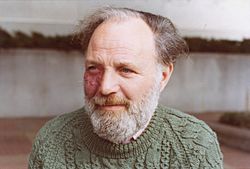Isadore Singer facts for kids
Quick facts for kids
Isadore Singer
|
|
|---|---|

Singer in 1977
|
|
| Born | May 3, 1924 |
| Died | February 11, 2021 (aged 96) Boxborough, Massachusetts, US
|
| Alma mater | University of Michigan (BA) University of Chicago (MS, PhD) |
| Known for | Ambrose–Singer theorem Atiyah–Singer index theorem Atiyah–Hitchin–Singer theorem Ray–Singer torsion Kadison–Singer problem |
| Spouse(s) |
Rosemary Singer
(m. 1956) |
| Awards | Bôcher Memorial Prize (1969) National Medal of Science (1983) Wigner Medal (1988) Steele Prize (2000) Abel Prize (2004) |
| Scientific career | |
| Fields | Mathematics |
| Institutions | Massachusetts Institute of Technology University of California, Berkeley Princeton University Columbia University University of California, Los Angeles |
| Doctoral advisor | Irving Segal |
| Doctoral students | Richard L. Bishop Andrew Browder David G. Ebin Dan Freed John Lott Hugo Rossi Linda Rothschild Gerald Schwarz Nancy K. Stanton Frank W. Warner |
Isadore Manuel Singer (born May 3, 1924 – died February 11, 2021) was an American mathematician. He was a very important professor at the Massachusetts Institute of Technology (MIT). He also taught at the University of California, Berkeley.
Singer is famous for his work with Michael Atiyah. They proved the Atiyah–Singer index theorem in 1962. This theorem helped connect different areas of pure mathematics and theoretical physics. In the early 1980s, Singer helped start the Mathematical Sciences Research Institute (MSRI). He founded it with Shiing-Shen Chern and Calvin Moore.
Contents
Biography
Early life and education
Isadore Singer was born on May 3, 1924, in Detroit, Michigan. His parents were immigrants from Poland. His father, Simon, worked as a printer and spoke Yiddish. His mother, Freda, was a seamstress. Isadore quickly learned English and then taught it to his family. He was born with a birthmark under his right eye.
Singer studied physics at the University of Michigan. He finished his degree in just two-and-a-half years, graduating in 1944. He did this so he could join the military. He served in the US Army in the Philippines as a radar officer. During the day, he ran a communications school for the Philippine Army. At night, he took correspondence courses in mathematics. This helped him prepare for advanced physics topics.
After his military service, Singer studied mathematics at the University of Chicago. He first planned to go back to physics. But he became very interested in math. He earned his master's degree in Mathematics in 1948. He then got his Ph.D. in Mathematics in 1950. His teacher was Irving Segal.
Career
In 1950, Singer worked at the Massachusetts Institute of Technology (MIT). He then worked at other universities like the University of California, Los Angeles, Columbia University, and Princeton University. In 1956, he returned to MIT as a professor. He stayed there for many years.
In 1979, he moved to the University of California, Berkeley. He was a Miller Professor there. He came back to MIT in 1983. He became the first John D. MacArthur Professor. In 1987, he was named an Institute Professor.
Singer was also involved in important science groups. He was part of the National Academy of Sciences and the White House Science Council. He helped create the Mathematical Sciences Research Institute. This is a non-profit group in Berkeley, California.
Isadore Singer passed away on February 11, 2021. He was 96 years old. He died at his home in Boxborough, Massachusetts.
Research
Isadore Singer worked with Michael Atiyah, a British-Lebanese mathematician. They found a way to connect two different areas of math: analysis (which deals with differential equations) and topology (which studies shapes). They solved a big math puzzle about how shapes could help count the number of solutions to certain math problems.
This work led to the Atiyah–Singer index theorem. This theorem created a new field of math called index theory. Their work also used something called the Dirac operator. This was a new discovery in geometry. Sometimes, it's called the Atiyah–Singer operator. Later, in the 1970s, scientists found that the Atiyah–Singer theorem could be used in physics.
Singer also worked with Richard V. Kadison. In 1959, they came up with the Kadison–Singer problem. This was a math puzzle inspired by quantum mechanics. It turned out to be important for engineering and computer science too. This problem was finally solved in 2013.
Singer also helped develop other important math ideas. These include analytic torsion and using heat equations in the Atiyah–Singer index theorem. Other important math ideas he contributed to are the Ambrose–Singer holonomy theorem and the McKean–Singer theorem.
Awards and honors
Isadore Singer was a member of several important groups. These included the National Academy of Sciences, the American Philosophical Society, and the American Academy of Arts and Sciences. He was also a member of the Norwegian Academy of Science and Letters. In 2012, he became a fellow of the American Mathematical Society.
He received many awards for his work. Some of them include:
- The Bôcher Memorial Prize (1969)
- The National Medal of Science (1983)
- The Eugene Wigner Medal (1988)
- The Steele Prize for Lifetime Achievement (2000)
- The Abel Prize (2004), which he shared with Michael Atiyah
Personal life
Singer was married twice. His first marriage was to Sheila Ruff. She worked with disabled children. They later divorced. His second marriage was to Rosemarie Singer. They were married until he passed away.
He had five children: Stephen, Eliot, Natasha (with Sheila), Emily, and Annabelle (with Rosemarie). His brother, Sidney, was a particle physicist. Sidney passed away in 2016.
See also
 In Spanish: Isadore Singer para niños
In Spanish: Isadore Singer para niños

